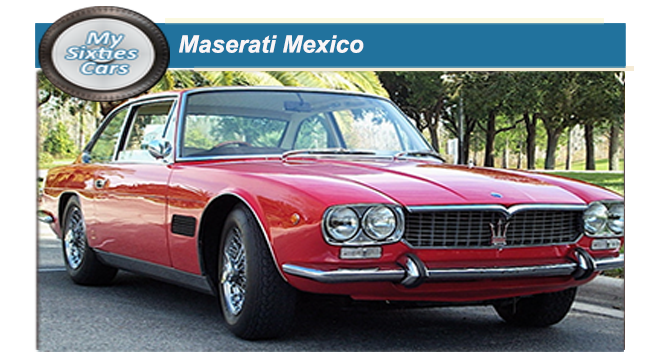
Launched at the Paris motor show of 1966 the latest Maserati model, the Mexico notchback coupe was destined to become one of the company’s best-known models, even though only 250 were produced.
Styled and built by Vignale, the four-seater rode a short-wheelbase variant of the Quattroporte sedan's platform. Early Mexi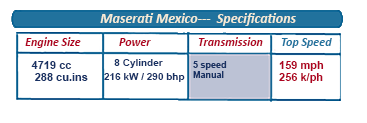 co coupes were powered by the 4719-cc V-8 engine also used in later Quattroportes.
These engines, hooked to a ZF five-speed manual gearbox, were capable of developing 290 horsepower.
Later versions were available with a 4.1-litre V-8 engine and could also be fitted with a three-speed automatic transmission.
Styling features included a low beltline with full hood and grille, squarish rear wheel openings, thin roof pillars, front vent wings, and large pentagonal rear quarter windows.
Quadruple
co coupes were powered by the 4719-cc V-8 engine also used in later Quattroportes.
These engines, hooked to a ZF five-speed manual gearbox, were capable of developing 290 horsepower.
Later versions were available with a 4.1-litre V-8 engine and could also be fitted with a three-speed automatic transmission.
Styling features included a low beltline with full hood and grille, squarish rear wheel openings, thin roof pillars, front vent wings, and large pentagonal rear quarter windows.
Quadruple 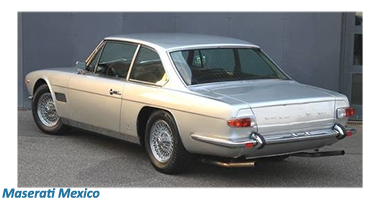 round headlamps stood alongside the rectangular grille with crosshatch pattern and centre insignia, and above rectangular park/signal lights.
A bodyside trim strip ran from the front wheel opening to the rear panel. A louvred section was evident at the cowl below the strip.
A demi-prominent'Maserati' script decorated the back panel, which contained protruding horizontal tail lamps. Leaf springs were used for the rear suspension (as on later Quattroportes). Wire wheels were standard.
round headlamps stood alongside the rectangular grille with crosshatch pattern and centre insignia, and above rectangular park/signal lights.
A bodyside trim strip ran from the front wheel opening to the rear panel. A louvred section was evident at the cowl below the strip.
A demi-prominent'Maserati' script decorated the back panel, which contained protruding horizontal tail lamps. Leaf springs were used for the rear suspension (as on later Quattroportes). Wire wheels were standard.
![]()
Rather than a 2+2 coupe with a minimal back seat, the Mexico ranked as a four-passenger rival to the sedan, allowing those in the rear to enjoy a bit of comfort.
The Mexico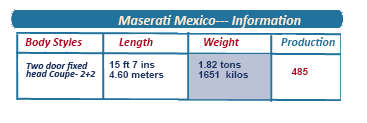 was intended to replace the 5000GT but lacked the performance, power and much of the style of its illustrious predecessor. Vignale's square-cut styling did not have the originality and flair of the 5000GT.
was intended to replace the 5000GT but lacked the performance, power and much of the style of its illustrious predecessor. Vignale's square-cut styling did not have the originality and flair of the 5000GT.
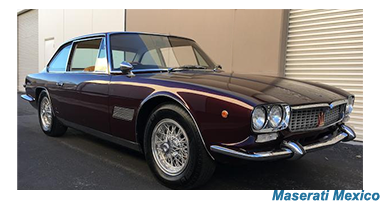 Apart from the shortened chassis, mechanically the New Mexico was much the same as the Quattroporte, with an identical 4.1-litre (252 cu in) V8 quad-camshaft engine. Live rear axle and leaf springs were fitted from the beginning, along with ventilated disc brakes — a first for Maserati.
The body was all steel and directly welded onto the oval tube frame.
The Mexico was a full (if cramped) four-seater aimed at the luxury market, meaning that it came with full luxury trim, including leather upholstery, a wooden dashboard, electric windows and a wide variety of the latest in in-car technology that was available in those days.
Apart from the shortened chassis, mechanically the New Mexico was much the same as the Quattroporte, with an identical 4.1-litre (252 cu in) V8 quad-camshaft engine. Live rear axle and leaf springs were fitted from the beginning, along with ventilated disc brakes — a first for Maserati.
The body was all steel and directly welded onto the oval tube frame.
The Mexico was a full (if cramped) four-seater aimed at the luxury market, meaning that it came with full luxury trim, including leather upholstery, a wooden dashboard, electric windows and a wide variety of the latest in in-car technology that was available in those days.
![]()
From 1969, air conditioning became standard, while power-assisted steering or an automatic gearbox was available, but only as optional extras.
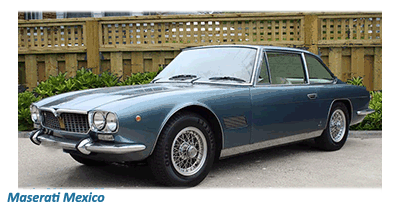 Maserati made some minor changes to Mexico going into the Sixties. These included changing the wire wheels for alloys.
Maserati made some minor changes to Mexico going into the Sixties. These included changing the wire wheels for alloys.
Like all Maseratis, the Mexico had its share of celebrity owners, the highest profiles was Ronald Reagan, at that time merely a star of Hollywood, who was destined to become President of the United States.
Italian actress Virna Lisi, and from the World of Sports, local hero and middleweight boxing champion of the World Nino Benvenuti were also proud to drive a Mexico.






